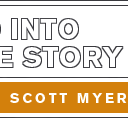One of the most effective aspects of Sarah Polley’s screenplay is how each of the women characters in that barn meeting emerges as their own protagonist. Either through a series of exchanges or a key confession, something essential to who each character is comes to light. Moreover, those moments each reflect the character’s unique experience upon the overall question of what they should do. By learning more about who each of them is, each eventually lands on a conclusion of what they want for themselves … and the other women. This is reflected in the choice they make: to leave.
That said, I think there is one character who feels like the central Protagonist: Ona, played by Rooney Mara. In the group interactions, she is often a character who provides a calm voice which helps to settle things down. Indeed, she has a line of dialogue, which I’ll feature when we discuss dialogue in the movie, which proves pivotal in moving the women toward a consensus about leaving.
Then there is her relationship with August (Ben Wishshaw). That is an important subplot as they must deal with his confession that he has always loved her. When Ona and the other women determine to leave, Ona talks August out of his despairing instinct to end his life by tasking him with staying in the community in order to instill in the boys (as their teacher) a more enlightened attitude.
There’s also the character Autje. She’s the narrator. I asked Sarah Polley about the choice to use voice-over narration and she said apart from the benefit of being able to use Autje to provide key details about the religious community, she also represented girls right at the cusp where they would become the next victims of the men. It’s like every time Autje is a spectator or participant in a scene, that threat to she and her friend looms like a dark cloud.
One final note: The Nemesis character is The Men. Since they leave early in Act One, they are “present” through the memory of their abhorent behavior and the rigidity of their patriarchal rule over the women. Interestingly, we never see their faces, not in any of the brief flashbacks … when we see them leaving to go bail out the men who were arrested. I asked Sarah Polley if this was intentional and she said she didn’t even realize they were filming the male characters so their faces were hidden, but once she did make that connection, they used that as a way of creating this kind of monstrous presence (my words, not hers).
The main takeaway for writers: Treat each character as their own protagonist. Even if they aren’t the actual Protagonist, their lived experience is they are the protagonist in their own lives.
Tomorrow: Themes.
